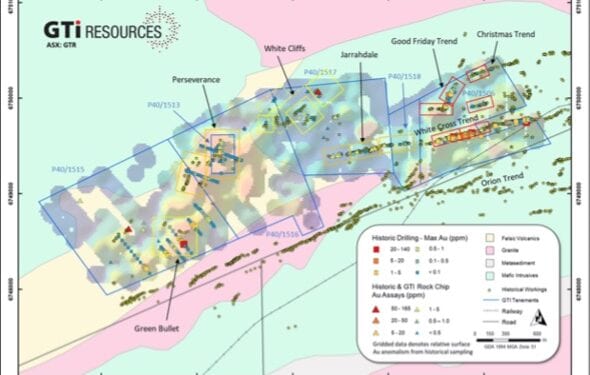Report Identifies Exciting Potential Of Niagara Licences
GTI Resources Ltd’s (ASX:GTR) confidence in its growing landholding position in the Niagara gold district in Western Australia has been significantly boosted by a new study into historical data from the region.
The independent WAMEX compilation report from CSA Global assessed the historical gold production and exploration activity and potential prospectivity at the company’s newly granted prospecting licences, P40/1515, P40/1516, P40/1517 and P40/1506 and the recently acquired P40/1513 and P40/1518 permits.
This contiguous land package over ~5km of mineralised trend now creates a significantly enlarged consolidated holding over extensive historic mine workings of the Niagara gold mining district.
The tenements incorporate the historic White Cross and Perseverance mining areas and smaller historic working trends including the Christmas and Good Friday trends. The Orion Trend extends ENE to the south of the tenements and hosts the historic Orion/Sapphire Mine.
Executive Director, Bruce Lane, said the compilation report from CSA has highlighted the material past production and drilling which has occurred on the newly consolidated land package.
“The report from CSA has now pulled together all of the known historical information available for the newly consolidated land package and what the report reveals has exceeded our expectations in terms of the exciting gold potential of the ground,” Mr Lane said.
“We are now evaluating our options to create shareholder value from the project as we prepare a plan and permits to properly test this historically heavily worked area using modern exploration techniques.”
The Niagara Goldfield was largely mined from 1898 up to the early 1900’s with production from the historic May workings dating up to 1914; the goldfield was briefly worked again in 1940 and 1941 but with limited success.
The independent compilation of mine records indicates that historical workings produced 5,100oz Auat a grade of 25.8 g/tbetween 1898 and 1914.
The report found that:
- Historical drilling has targeted the historical workings at shallow levels with drilling typically to 50m depth or shallower.
- An opportunity exists to extend the known mineralisation from historic workings to deeper levels and along strike with further drilling.
- The mineralised trends that represent high‐priority, advanced exploration targets in the east of the project area are collectively up to 2.5 km in length, including 1.6 km of the White Cross trend from the May workings in the east to the Jarrahdale‐Spinaway workings in the west, 400m of the Good Friday trend, and 500m of the Christmas trend.
The project containsthree high priority advanced exploration target areas,twosecond priority intermediate exploration target areas and threeearlier stage third priority exploration target areas.












